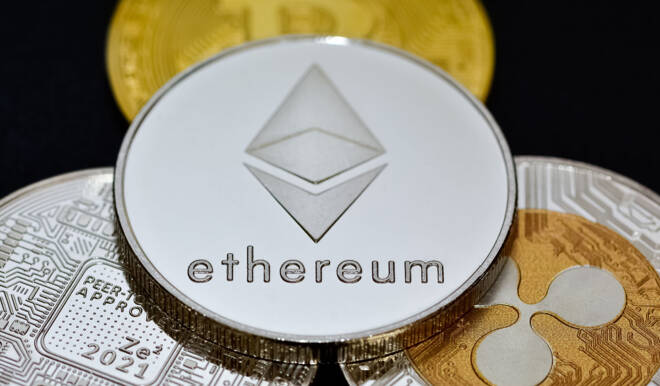Advertisement
Advertisement
Ethereum Prices Forecast: Ether Rides Futures Wave, but Staking Casts Shadows
By:
ETH outperforms with bullish momentum; however, staking inflows dip, signaling potential Ether price shifts.
In this article:
Key Insights:
- Ethereum nearly touched $1,700 on Sunday, marking its third unsuccessful attempt in consecutive sessions.
- Bullish winds from SEC’s anticipated nod for ETH-Futures ETFs contrast bearish staking signals.
- ETH outpaces the broader crypto market, driven by optimism around futures and regulatory developments.
Sunday Overview
Ethereum (ETH) rose by 0.96%. Following a 0.48% gain on Saturday, ETH ended the week down 8.38% to $1,685. Despite the bullish session, ETH fell short of $1,700 for the third consecutive session.
Optimism Over ETH-Futures ETFs and Coinbase Futures Deliver Support
ETH outperformed the crypto market for the second consecutive session on Sunday. Several factors contributed to the bullish momentum throughout the weekend.
Investor sentiment toward the expected SEC approval of ETH-Futures ETFs remained a primary driver. However, news of the Commodity Futures Trading Commission giving Coinbase (COIN) the green light to launch BTC and ETH futures was also bullish.
Last week, Coinbase CEO Brian Armstrong shared the news, saying,
“Major moment for crypto regulatory clarity in the US. This has been a multi-year process toward approval, and we’re excited to finally be launching federally regulated crypto derivatives with margin to our US customers. When there is a clear path to register, we do.”
Armstrong’s final sentence was a swipe at the SEC, which filed charges against Coinbase for operating as an unregistered securities exchange, broker, and clearing agency. Additionally, the SEC filed charges against Coinbase for the unregistered offering and selling of securities in connection with its staking-as-a-service program.
Staking Statistics Send Bearish Signals Despite the Bullish Weekend
Staking inflows declined further on Sunday, falling to sub-30,000 following a recent trend of weekend retreats.
According to CryptoQuant, staking inflows retreated from 62,624 on Saturday to 24,448. The decline to sub-30,000 was a bearish price signal.
The overnight withdrawal profile was bearish, with ETH principal withdrawals remaining above normal levels. Withdrawal projections for the morning session are also bearish. Projections show ETH withdrawals will sit at above-normal withdrawal levels.
The increase in ETH withdrawals could lead to increased flows to exchanges to pressure current price levels through increased supply.
On Sunday, the net ETH staking balance stood at a 61,950 surplus ($103.22 million), down 34.41% over 24 hours. Deposits totaled 65,230 versus withdrawals of 3,280.
According to TokenUnlocks, total pending withdrawals stood at 45,970 ETH, equivalent to approximately $77.39 million. Notably, the staking APR stood at 4.92%, down 1.01% over 24 hours. The downward trend in the staking APR, the slide in the net staking balance, and rise pending withdrawals are bearish price signals.
Ethereum Price Action
This morning, ETH was down 0.17% to $1,682. A range-bound start to the day saw ETH fall from an early high of $1,686 to a low of $1,680.
Daily Chart
The Daily Chart showed ETH held above the $1,670 – $1,650 support band. Despite the bullish weekend, ETH remained below the 50-day and 200-day EMAs, sending bearish near and longer-term price signals.
Looking at the 14-Daily RSI, 26.29 showed ETH in oversold territory. However, the RSI aligns with the EMAs, signaling a fall through the $1,670 – $1,650 support band to bring sub-$1,600 into play. A return to $1,700 would support a run at the 200-day EMA and the $1,795 – $1,815 resistance band.
4-Hourly Chart
Looking at the 4-Hourly Chart, the ETH/USD faces strong resistance at $1,700. ETH hovers above the $1,670 – $1,650 support band. However, ETH sits below 50-day and 200-day EMAs, affirming bearish near and longer-term price signals.
An ETH move through $1,700 would give the bulls a run at the 50-day EMA and the $1,795 – $1,815 resistance band. However, failure to target the 50-day EMA would leave the $1,670 – $1,650 support band and sub-$1,600 in view.
The 14-4H RSI reading of 38.06 shows ETH sitting in oversold territory, with selling pressure outweighing buying pressure. Significantly, the RSI aligns with the 50-day EMA, signaling a return to sub-$1,600.
About the Author
Bob Masonauthor
With over 20 years of experience in the finance industry, Bob has been managing regional teams across Europe and Asia and focusing on analytics across both corporate and financial institutions. Currently he is covering developments relating to the financial markets, including currencies, commodities, alternative asset classes, and global equities.
Latest news and analysis
Advertisement
